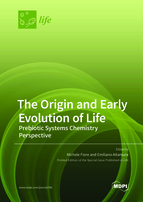The Origin and Early Evolution of Life: Prebiotic Systems Chemistry Perspective
A special issue of Life (ISSN 2075-1729). This special issue belongs to the section "Origin of Life".
Deadline for manuscript submissions: closed (31 December 2021) | Viewed by 70757
Special Issue Editors
Interests: systems chemistry; systems biology; prebiotic chemistry and prebiotic systems chemistry; origin of life; prebiotic synthesis of amphiphiles; total synthesis of racemic and enantiopure phospholipids; evolvable molecular systems synthesis of fluorescent clickable probes; synthesis and application of glycolipids; radical reactions
Special Issues, Collections and Topics in MDPI journals
Interests: artificial photosynthetic cell; synthetic biology; systems chemistry; origin of life; giant lipid vesicles; ATP production in compartmentalized systems; natural and artificial organelles; liposomes; confined enzymatic reactions; protein chemistry; membrane proteins; confocal microscopy; flow cytometry
Special Issue Information
What is life? How, where, and when did life arise? These questions have remained most-fascinating over the last hundred years. Aristoteles 2400 years ago postulated that “nature does not do anything endless” and many years later the German biologist Carl Richard Woese (1928 -2012) emphasized the urgency of conducting in-depth studies in search of what we call Life with the following words: “Biology today is no more fully understood in principle than physics was a century or so ago. In both cases the guiding vision has (or had) reached its end, and in both, a new, deeper, more invigorating representation of reality is (or was) called for”. (Woese, A New Biology for a New Century. Microbiol Mol Biol Rev 68:173–186. https://0-doi-org.brum.beds.ac.uk/10.1128/MMBR.68.2.173-186.2004) Systems chemistry (Ashkenasy G, Hermans TM, Otto S, Taylor AF (2017) Systems chemistry. Chem Soc Rev 46:2543–2554. https://0-doi-org.brum.beds.ac.uk/10.1039/C7CS00117G) is the way to go to better understan the problem and to try replying the unsolved question about the origin of Life. Self-organization, thanks to the role of lipid boundaries made possible the rising of protocells. The role of this boundaries is to spatially distinct, separate and co-locate micro-environments; to protect and keep them at defined concentrations; to enable a multitude of often competing and interfering biochemical reactions to occur simultaneously.
The aim of this Special Issue is to summarize the latest discoveries in prebiotic chemistry of biomolecules field, self-organization, protocells and origin of life. In recent years, thousands of excellent reviews and articles appeared in the literature and some breakthroughs have already been achieved. However, a great deal of work remains to be done. I am deeply convinced that, beyond the borders of the traditional domains of scientific activity, the multidisciplinary character of the present Special Issue, essentially based on systems chemistry (and biology, physics, geology, mineralogy and astronomy) leaves space for anyone to creatively contribute to any aspect of these and related relevant topics. We hope that the presented works will be stimulating for a new generation of scientists that are taking their first steps in this fascinating field. Submission of original research, scientific perspectives and literature reviews on this topic are deeply encouraged.
For hypothesis and perspective article, they should not simply be novel ways of thinking about life, they should also be testable, either by future observations or by experiment.








